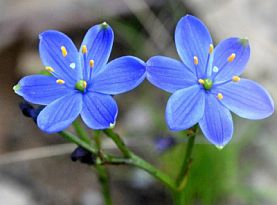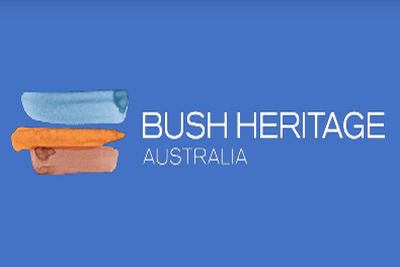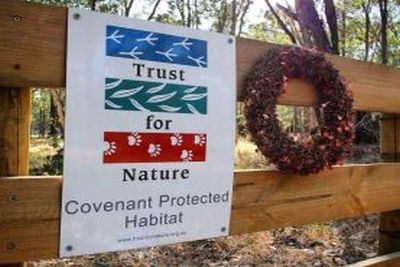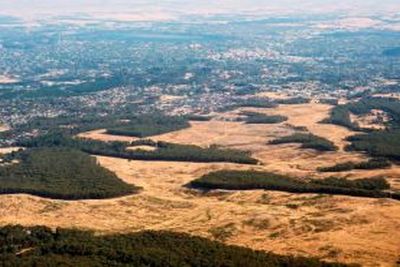SWIFFT Seminar notes 23 March 2023
NGO’s role in habitat restoration and management
SWIFFT seminar notes are a summary of the seminar and not intended to be a definitive record of presentations made and issues discussed.
This SWIFFT seminar was conducted online with 160 participants via Microsoft Teams. SWIFFT wishes to acknowledge support from the Department of Energy, Environment and Climate Action (DEECA), Victoria in organising the seminar and thank speakers for their time and delivery of presentations. Also, thanks to Michelle Butler who chaired the session from Ballarat and acknowledged Traditional owners, Elder’s past and present on the lands covered by the meeting.
This Seminar highlights some of the essential and important restoration and conservation work being carried out at both a local and landscape level on private land by non-government organisations, often driven by the community wanting to protect or restore nature in their area.
Key points summary
Deepening conservation outcomes in Victoria: protected areas, partnerships, and natural capital
- Bush Heritage is primarily focused on buying up and managing land of high conservation value to protect it in perpetuity.
- Bush Heritage has over 46,000 supporters; it employs over 130 staff and manages 42 Bush Heritage owned reserves (1.2 million ha) plus 26 Aboriginal partnerships (10.1 million ha) across Australia.
- Bush Heritage operates with a ‘Right-way’ approach based on respect, sharing knowledge, listening and learning. It brings together different knowledge systems for thinking, planning and acting for the benefit of people and country.
- In Victoria, Bush Heritage has identified the Kara Kara - Wedderburn Priority Focal Landscape a priority area, working in partnership with Dja Dja Wurrung Traditional Owners.
Permanent protection of private land – why is it important?
- Trust for Nature was established in 1972 under the Victorian Conservation Trust Act 1972. It is the only conservation organisation in Victoria which is empowered by law to protect habitat on private land.
- Trust for Nature administers 1657 registered covenants covering 77,910 ha of private land with permanent conservation protection plus 42 Trust for Nature Reserves covering 35,725 ha.
- Stewardship Agreements are aimed at supporting landholders who enter into covenants to maintain or enhance the conservation values of the land.
- The significant loss of vegetation on Victoria’s private land highlights the need to have more private land areas under permanent protection thereby conserving biodiversity values.
Scaling up land restoration in Central Victoria through connecting communities and ecosystems
- Biolinks Alliance was formed in 2009 and plays a unique role in building partnerships and capacity building for a range of environmental groups and networks across central Victoria.
- The Alliance represents 18-member community environment groups (Landcare and Conservation Management Networks, Friends of Groups).
- Biolinks Alliance is running a number of pilot landscape projects – ‘Local to Landscape’ planning system, advocacy brokering and partnerships.
- Biolinks Alliance ‘Local to Landscape’ brings together the community, Landholders, Landcare, Community conservation groups, other non-government and Government organisations to learn and agree on priority actions to tackle large landscape issues.
Imagining landscape restoration opportunities
- Friends of Canadian Corridor have been instrumental in the creation of a multi-use Forest Park on the east side of Ballarat which incorporated existing state forest and 240 hectares of ex plantation land.
- There are 1065 registered Friends and 82 friendly community organizations with an interest in the Canadian Corridor.
- The Friends Group uses a number of platforms to engage and educate people about the park’s flora and fauna and mining heritage.
- The Bunanyung Landscape Alliance is a community driven alliance aimed at landscape - scale projects that protect and/or enhance land & waterscapes south of Ballarat covering the catchments which flow towards Geelong.
- A key project of the Alliance is creation of a biolink between the Enfield Forest and the Wombat Forest.
List of topics and speakers
- Deepening conservation outcomes in Victoria: protected areas, partnerships, and natural capital - Eleanor Hetharia - Head of Region South-East, Bush Heritage Australia
- Permanent protection of private land – why is it important? - Karen Tymms - Statewide Stewardship Coordinator, Trust for Nature
- Scaling up land restoration in Central Victoria through connecting communities and ecosystems - Sophie Bickford - Executive Director of Biolinks Alliance
- Imagining landscape restoration opportunities - Jeff Rootes - Secretary of Friends of Canadian Corridor and Secretary: Bunanyung Landscape Alliance
SPEAKER SUMMARIES
Speaker summaries are adapted from presentations and are not intended to be a definitive record of presentations made and issues discussed.
Deepening conservation outcomes in Victoria: protected areas, partnerships, and natural capital
Eleanor Hetharia - Head of Region South-East, Bush Heritage Australia
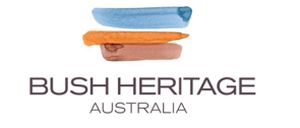
Eleanor made her presentation from Launceston, Tasmania (Lutruwita) and acknowledged the Palawa people as being the traditional owners of the land.
Eleanor has been working in the conservation sector for over 20 years in a variety of roles. Her position as Head of Region South-East for Bush Heritage spans New South Wales, Australian Capital Territory, Victoria and Tasmania. Eleanor’s focus is on Bush Heritage Conservation Reserves and Conservation partnerships.
About Bush Heritage
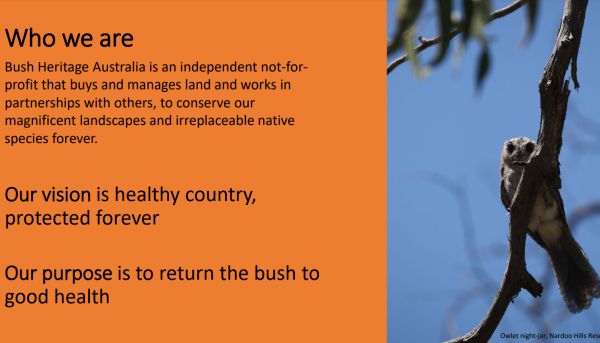
Bush Heritage is primarily focused on buying up land of high conservation value and protecting it in perpetuity with ongoing management of those lands for conservation. Bush Heritage adopts a partnership approach both on reserves and off reserves to leverage the best conservation outcomes. Source: Eleanor Hetharia.
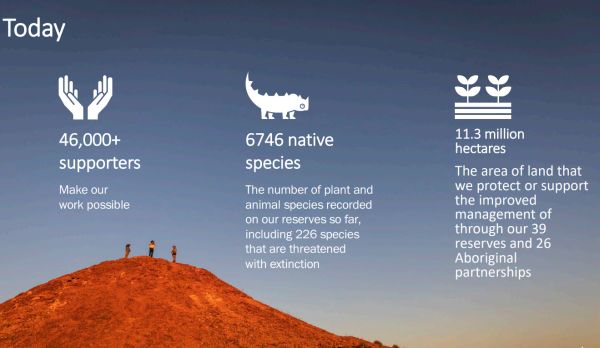
Priority Landscapes
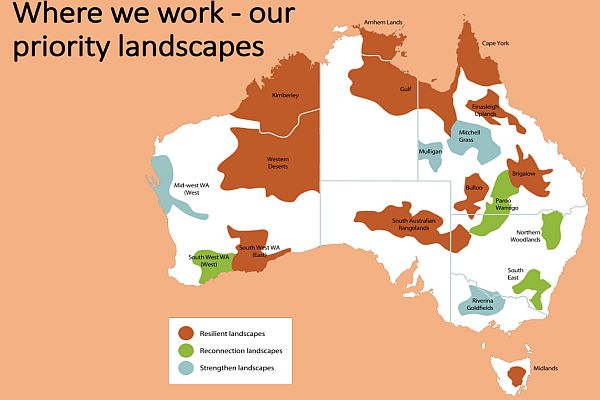
Elenore spoke about the development of a framework for how Bush Heritage delivers its strategy. In 2015, the Priority Landscapes took account of how they might complement the National Reserves System. In 2021-22, Bush Heritage completed a review of Priority Landscapes and updated them taking into account their condition and threats. In addition, Climate Change impacts were included, identifying areas that are vulnerable and areas that are more resilient. Three main categories have been identified:
- Resilient Landscapes (brown) – areas likely to be more adaptable to Climate Change. Focus – large scale acquisitions and partnerships with Aboriginal community.
- Reconnection Landscapes (green) – areas with a moderate to medium Climate Change threats. Focus – build up reconnection and active restoration to build the landscapes resilience.
- Strengthen Landscapes (pale blue) – areas which are expected to experience high level impacts from Climate Change and also development. Focus – collaboration and partnerships, invest in shoring up reserves to provide more resilience.
Bush Heritage 2030 Strategy
Elenore spoke about the 2030 Strategic Plan which sets out to deepen and double Bush Heritage’s impact by 2030. The strategy incorporates 3 impact models:
Reserves
- Deepening ecological and cultural health outcomes
- New reserves
Aboriginal partnerships
- Deepening healthy country plan delivery
- New Partnerships
Natural Capital in Agriculture
- Environmental services
- Biodiverse carbon capture
- Natural products
Right way approach
Elenore emphasised one of the means being used to deliver the Strategy is the 'Right way approach'. Bringing together different knowledge systems for agreed mutual outcomes and objectives. Its core principles include collaboration, respect and trust.
Right-way’ science is an approach based on respect, sharing knowledge, listening and learning. It brings together different knowledge systems for thinking, planning and acting for the benefit of people and country.
Bush Heritage also applies the Right way approach to Right way planning, involving collaboration with partners across the landscape to achieve a shared vision.
Right way fire – using cultural burning as a management tool.
The Right way approach is very important to Bush Heritage and underpins the way they operate.
Bush Heritage Reserves and Partnerships
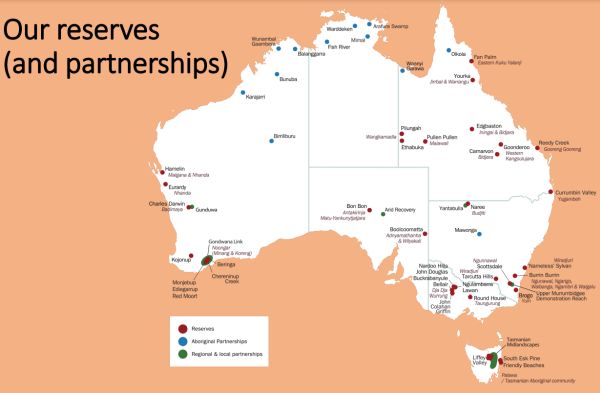
Priority area in Victoria
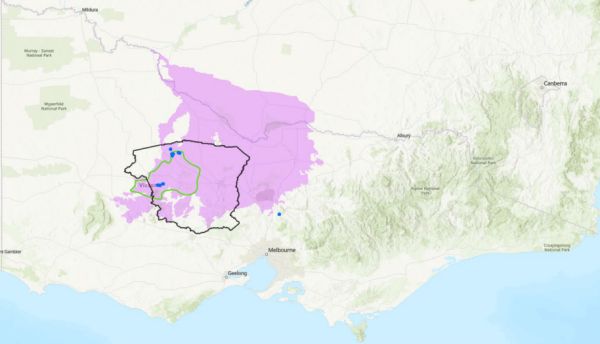
Elenore spoke about the highly fragmented and modified landscape in and around the Kara Kara - Wedderburn Priority Focal Landscape. She pointed out that there are still high value remnants of native bushland and native grasslands which makes this area important for protection, acquisition and restoration. There are opportunities to link up existing Bush Heritage reserves with Public Land areas and strategic acquisitions to restore the landscape. As well as significant flora and fauna values, including a number of threatened species the area is also culturally significant.
Conservation management process
Elenore discussed the rigorous processes used in developing and implementing strategies and actions for conservation projects and reserves.
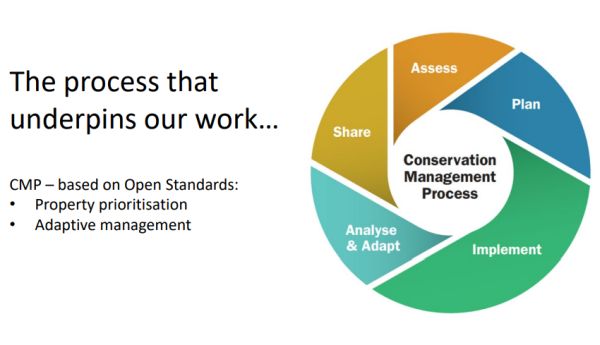
Top six on-ground actions for the Kara Kara - Wedderburn Priority Focal Landscape
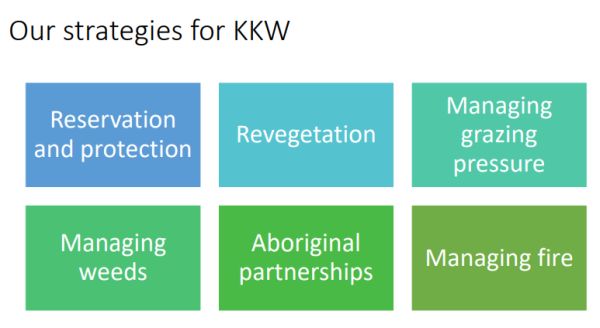
Partnerships in the Kara Kara - Wedderburn Priority Focal Landscape
Aboriginal Partnerships Wurreka Galkangu
Aboriginal Partnerships, Wurreka Galkangu – creating shared landscape level plans which identify common values and visions. This partnership incorporates ‘Right way planning’ with Dja Dja Wurrung Traditional Owners, developing a new plan for Kara Kara Wedderburn, blending traditional cultural knowledge systems with western science.
Victorian Landscape Conservation Partnership
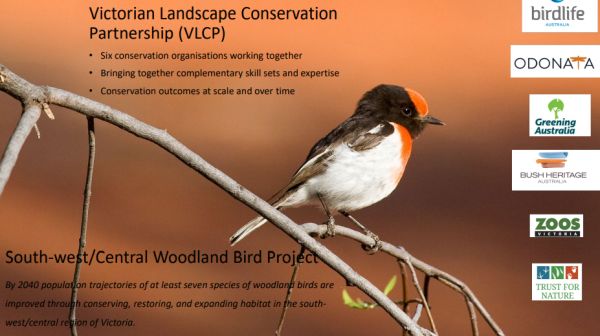
Victorian Landscape Conservation Partnership - partnerships with six conservation organisations working together for conservation outcomes at scale over time.
South-west/Central Woodland Bird Project - by 2040 population trajectories of at least seven species of woodland birds are improved through conserving, restoring, and expanding habitat in the southwest/central region of Victoria.
Natural Capital Agriculture
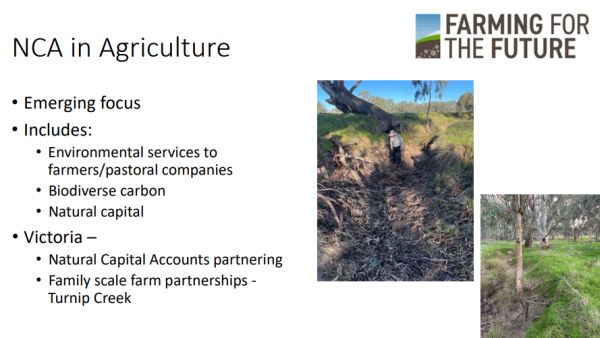
Key points from questions
- Bush Heritage is likely to form partnerships with Landcare groups in priority focal landscapes over time.
Due to time constraints questions were limited.
Speaker summaries are adapted from presentations and are not intended to be a definitive record of presentations made and issues discussed.
Permanent protection of private land – why is it important?
Karen Tymms - Statewide Stewardship Coordinator, Trust for Nature
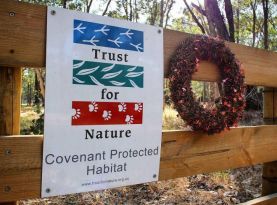
Karen acknowledged the Traditional Owners of the lands where she presented from and the land management knowledge and techniques used for thousands of years prior to European settlement.
Karen also pointed out that in more recent years there have been important gains in recognising the role of traditional land management on projects in Victoria.
Trust for Nature’s role in permanent protection of conservation values on private land
Trust for Nature was established in 1972 under the Victorian Conservation Trust Act 1972. It is the only conservation organisation in Victoria which is empowered by law to protect habitat on private land.
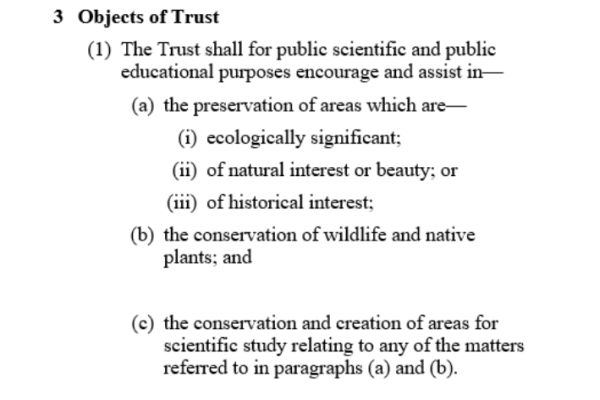
Other conservation options for permanent protection of private land
Karen spoke about a number of other permanent protections measures applicable in Victoria:
- Section 69 permanent protection agreements applied to Land Titles and Section 173 agreements with Local Government.
- Land acquisition
- Indigenous protection agreements
- Land Tenure changes where the Crown buy
- Management agreements
- Off-sets as result of planning decisions
- Environmental markets
How Trust for Nature permanently protects high conservation value private land
Karen spoke about the four main mechanisms used to protect private land in Victoria:
- Legal agreement registered on Title which is an agreement between TFN and the landowner and any other subsequent owner
- Restrictive agreements can incorporate restriction on activities or the use of the covenanted land e.g., restriction on recreational off-road usage
- Trust for Nature owned reserves – currently there are 44 TFN owned reserves in permanent protection
- Revolving fund – used to purchase land and on-sell the land with a conservation covenant on title or transfer purchased land to the Crown for permanent protection
Stewardship Agreement
Karen explained that the Stewardship Agreement is an agreement in perpetuity aimed at supporting landholders. It enables TFN to work collaboratively with covenators to maintain or enhance the conservation values. It includes:
- Education
- Technical advice
- Practical assistance
- Monitoring
- Financial assistance
When necessary, compliance techniques are used to enforce covenant conditions. TFN works very hard to work with new landowner when there is a change in land ownership to ensure the covenant conditions apply and new owners are familiar with the conservation values of the land.
Trust for Nature partnerships
Karen emphasised the partnership approach used by TFN, with 140 partnerships across various organisations. A number of TFN’s projects are funded by philanthropic and public donations. Federal and State Government also provide funding which enable TFN to achieve its goals. Karen pointed out that there are also commercial agreements involving Council planning and off-sets for permanent protection. TFN can also undertake activities as a fee for service.
Importantly there are self-funded covenants and the landowners who partner with TFN to ensure permanent protection of conservation values on their land. Karen explained that a tremendous amount of talking with landowners is required to explain the covenant process as placing a covenant on title is a major step.
TFN covenant & reserves in Victoria
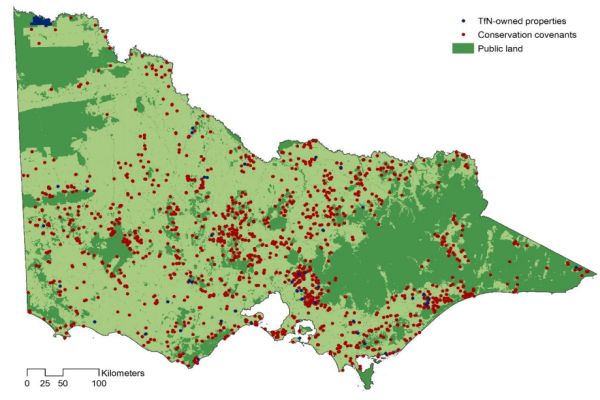
TFN permanently protected areas (covenants and TFN reserves) as at 2022. Dots indicate location of TFN reserves and covenants. Public Land (green). Source: Karen Tymms - Statewide Stewardship Coordinator, Trust for Nature.
1657 registered covenants - 77,910 ha of private land with permanent conservation protection
42 Trust for Nature Reserves – 35,725 ha
The need to permanently protect private land with biodiversity values
Karen pointed out that Victoria has 14.3 million ha in private ownership but when you look at the changes to our landscape in terms of vegetation loss there has been an incredible change since European settlement.
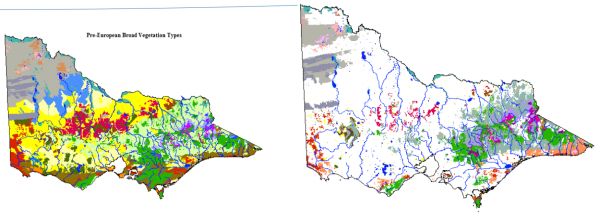
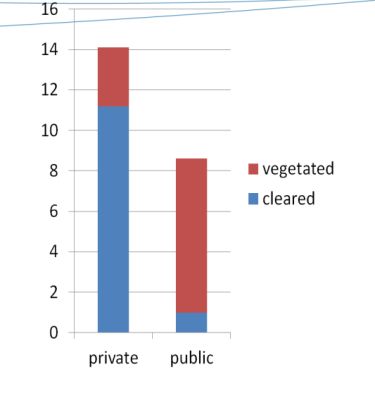
The significant loss of vegetation on Victoria’s private land highlights the need to have more private land areas under permanent protection thereby conserving biodiversity values.
TFN Statewide Conservation Plan (SCP) - ecosystem representation
Karen spoke about ecosystem representation or the need to ensure that a certain percentage of each bioregion is protected in order to keep those ecosystems functioning. TFN has developed a Statewide Conservation Plan based on the concept of ecosystem representation. The Trust has identified 18 focal landscapes across Victoria that provide the best opportunities for maintaining and improving viable ecosystems and populations on private land.
Trust for Nature's focal landscapes total 2,099,282 ha of land of which 89% is on private land.
Why we need to scale up protection of biodiversity on private land
Karen used two examples of the ongoing decline of biodiversity on private land.
1. Decline of the Grey-crowned Babbler in Victoria
Karen used the example of how a decline in one species can highlight the need for protecting private land. Karen spoke about a number of accounts from people who noted the Grey-crowned Babbler to be commonly observed. By the year 2000 it is now Extinct in most of the locations where it was once common.
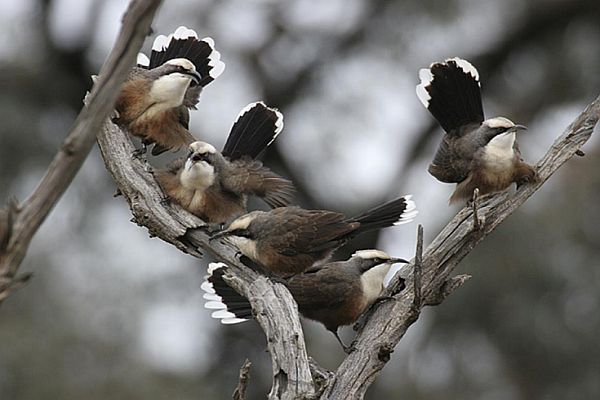
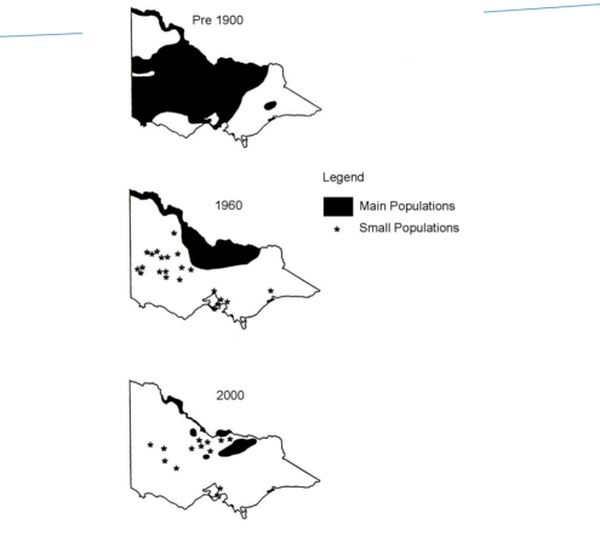
Karen's example of the Grey-crowned Babbler’s decline is not unique to this species. Karen emphasised that similar declines have been experienced by a large number of woodland birds and other species.
The loss of key-stone species such as the Grey-crowned Babbler is an indicator that a much broader loss is occurring across ecosystems.
2. Loss of biodiversity due to land clearing for cropping
Karen spoke about another example involving land clearing for cropping in Gippsland and why there is such a strong need to protect private land with biodiversity values. Karen showed a map of Gippsland which indicated that in the last 10-12 years there are numerous examples of vegetation being cleared for cropping – once the native vegetation is cleared the biodiversity values are gone and will most likely never be recovered.
Karen acknowledged the dedication of landowners involved in the stewardship program to permanently protect land through a covenant, a legal instrument which secures the biodiversity values in perpetuity.
Key points from questions
After the 2019/20 bushfires TFN received Federal Government funding to work with landowners who had TFN covenants and indirectly with communities in Local Government Areas impacted by the fires.
Covenanted properties can include restrictions such as the removal of soil, types of businesses that can be carried out and subdivisions. There are general restrictions ensuring the flora and fauna is not harmed. These are all worked out as part of the management plan for the land involved.
The process to work towards a covenant on a property can take 12–18 months as there is a process to ensure the landowner is fully aware of the covenant outcomes and that all the necessary legal processes have been undertaken. All covenants are signed off by the Minister. TFN is currently looking at streamlining the process so that the time to get a covenant is reduced to 6 months.
Control of unwanted access by people causing damage to the property e.g., off road trail bikes, requires secure boundary fencing.
TFN engages with Councils to apply a rate rebate program for covenanted properties. At a state level, policy work is being carried out to address issues with Victorian Land Tax on covenanted properties.
TFN is looking at protecting landscape clusters of climate refuges in partnership with Traditional Owners.
It is likely that TFN will ramp up opportunities for volunteering into the future.
Speaker summaries are adapted from presentations and are not intended to be a definitive record of presentations made and issues discussed.
Scaling up land restoration in Central Victoria through connecting communities and ecosystems
Sophie Bickford - Executive Director of Biolinks Alliance
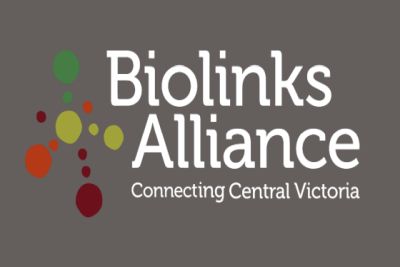
Sophie acknowledged Taungurung and Dja Dja Wurrung Traditional Owners and Elders of the lands where Biolinks Alliance operates.
Biolinks Alliance plays a unique role in building partnerships and capacity building for a range of environmental groups and networks across central Victoria.
Who are Biolinks Alliance?
Biolinks Alliance offers scientific expertise and leadership that supports communities to learn, collaborate and act strategically for nature – partnering with governments and other conservation organisations to urgently restore large landscapes in Central Victoria.
Biolinks Alliance was formed in 2009 and has since established itself in the conservation sector as a credible leader and advocate for strategic conservation across the whole of the landscape and embedded restoration practices.
Governance of Biolinks Alliance is undertaken by a skills-based Board. There are 8 expert staff; ecologists, facilitators and management. The Alliance represents 18-member community environment groups (Landcare and Conservation Management Networks, Friends of Groups).
Where does Biolinks Alliance work?
Sophie explained that Biolinks Alliance covers the Central Victoria, an area from the Grampians to the Benalla area and from the Macedon area almost up to the Murray River.
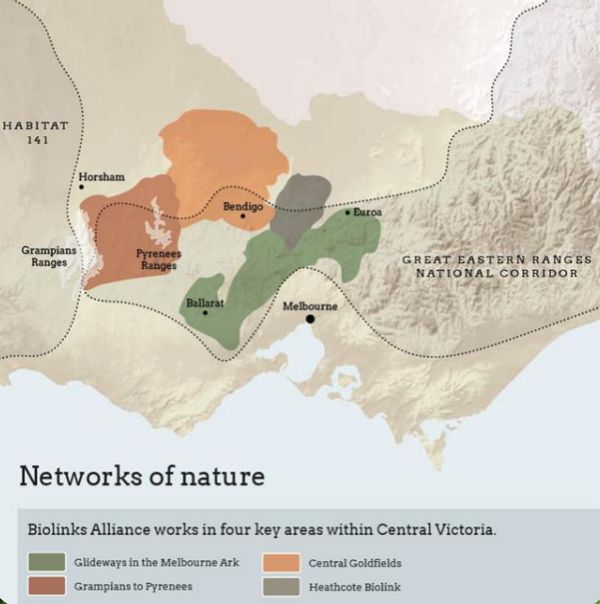
Biolinks Alliance covers multiple Bioregions and landscapes with climatic graidents. with 4 key network areas: Glideways in the Melbourne Ark (green), Grampians to Pyrenees (dark brown), Central Goldfields (light brown) and Heathcote Biolink (grey).
The area contains very high biodiversity values but heavy transformed due to high levels of private land clearing and habitat modification. Sophie pointed out that 26 native animal species have been lost from the region with 198 animal species and 575 plant species threatened with extinction.
Why yet another conservation organisation?
Sophie discussed some of the reasons why Biolinks Alliance was formed which includes a recognition that there is a need to restore and reconnect landscapes at a large spatial scale for climate change adaptation, these are areas between 200-400 km in south-east Australia. Whilst Landcare operates in segments of the area concerned there is a need to be able to harness the power of all groups and networks across the landscape and across all land tenures.
Sophie highlighted that 50% of Australia’s threatened species only occur on private land. Biolinks Alliance can be of value in connecting remnant habitat, enabling species to adapt to climate change and creating a matrix of private land to support biodiversity, in particular threatened species.
How Biolinks Alliance works
Sophie provided a broad overview of Biolinks Alliance processes which focus on knowledge sharing, networking and scaling up objectives for landscape restoration. Sophie felt it is also important to share evaluation and successes of projects.
At present there are also Pilot landscape projects – ‘Local to Landscape’ planning system Advocacy Brokering and partnerships.
Conservation communities ‘Local to Landscape’
Biolinks Alliance ‘Local to Landscape’ brings together community members e.g., Landholders, Landcare, Community conservation groups, other non-government and Government organisations to learn and agree on priority actions to tackle large landscape issues.
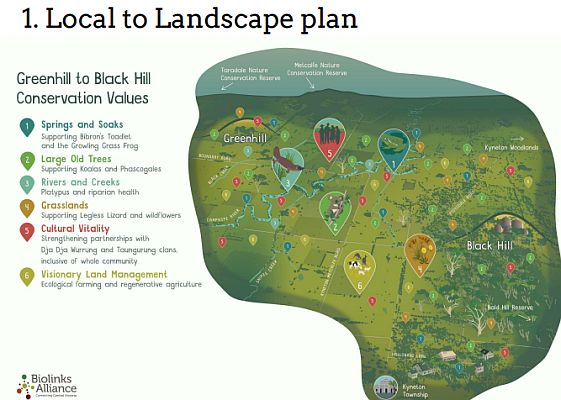
Sophie pointed out that when you take a close look at what might otherwise appear a degraded landscape you can often find that there are pockets of high value remnants which provide a basis to work from.
Local to Landscape prospectus
The Local to Landscape prospectus contains key strategies to action the 'Local to Landscape' conservation plan. Components of the prospectus include:
- Innovative demonstration restoration projects
- Community engagement and learning
- Fundraising
- Wider partnerships
Example: Heathcote ‘Local to Landscape’ Plan
Sophie spoke about this project as it one of the most established projects being into its 3rd year. Although there is no Landcare operating, Biolinks Alliance carried out a 2-year engagement with the community culminating in the Heathcote ‘Local to Landscape’ plan. The area still has a lot of remnant vegetation on private land and in scatted Parks & Reserves. Conservation of large old trees was identified as a priority. Waterways and healthy soils were also identified as requiring attention for restoration.
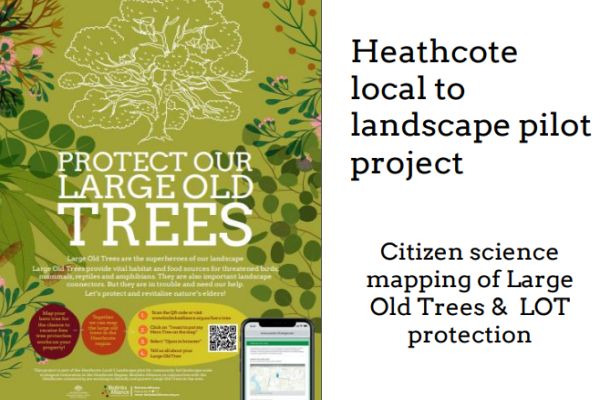
Other pilot projects associated with the Heathcote ‘Local to Landscape’ plan:
- Conservation of Swift Parrots – enhancement of box-ironbark remnants on bush blocks
- Climate-proofing landscape demonstration projects – restoration of soil hydrology to mitigate against impacts from climate change.
- Citizen Science – ecological monitoring program
Example: Citizen Science Surveys
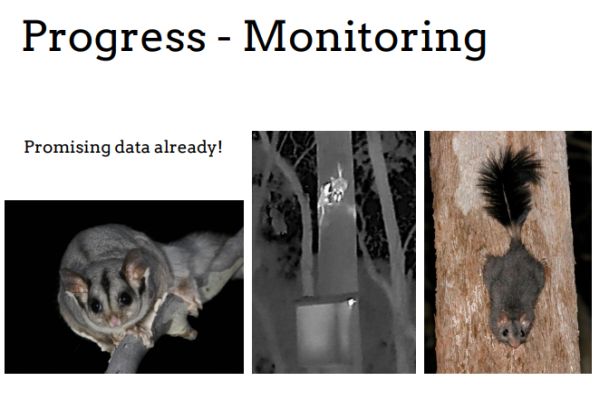
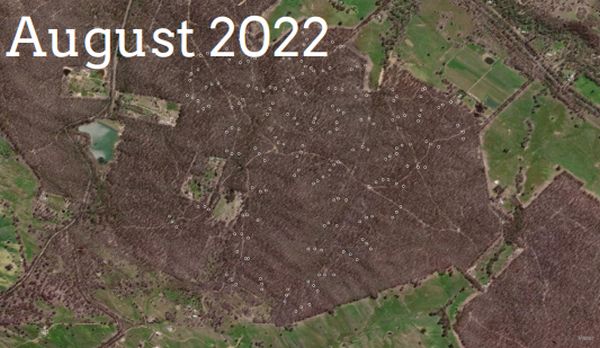
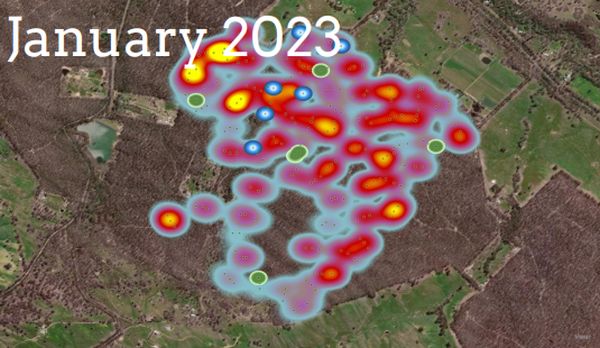
At least 399 individual Sugar Gliders have used the nest boxes.
Heathcote ‘Local to Landscape’ project implementation year 2
Sophie spoke about the large number of approvals that were required for on-ground restoration works as part of the Heathcote ‘Local to Landscape’ project. Works will start in Autumn 2023 as all the approvals are now in place.
A steering committee has been formed to guide the project into its second year. 261 locals have been involved in events, including Citizen Science workshops. $651,346 has been raised for projects. Most of the funding has come from Philanthropic Trusts and major donations. Outcomes so far include 125 ha restored or protected; 138 ha approved for restoration. Funding beyond 2024 to 2030 is being investigated.
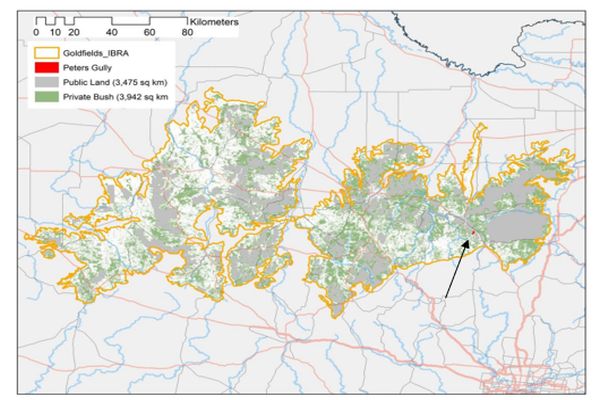
Future planning
Knowledge sharing across the network
Sophie spoke about the importance of knowledge sharing and some of the initiatives put forward by Biolink Alliance including seminars and an on-line knowledge hub.
Future funding models
Sophie spoke about the need to secure future funding models for projects. She posed the questions;
- How can we build sustainability into long-term projects for landscape-scale ecological repair?
- How can we capture the willingness of the broader community to take action for nature at this critical time?
Sophie has found that people in the broader community are happy that these types of projects are being carried out and want to be connected and contribute via land management, Citizen Science or fundraising. A Community fundraising model – pilot was developed for the Greenhill project which raised $42,000 with over 250 people being involved.
Sophie felt that we need to develop a culture of stewardship and collaboration leading to ecosystem repair. We need to act now as time is running out, our landscapes are being subject to ever increasing threats from climate change, fire, floods, invasive species and urbanisation.
Key points from questions
There is a recognition that we have lost some of the ecosystem engineers such as native marsupials that dig the leaf and soil.
Wombats occur in some areas of the Central Highlands but creating biolinks will help in movement through areas that are currently cut off due to fragmentation of habitats.
When trying to build community support for habitat restoration projects it often happens that the movement starts with just a few keen people but over time builds as more people become aware of what is being achieved.
Heathcote ‘Local to Landscape’ plan
Speaker summaries are adapted from presentations and are not intended to be a definitive record of presentations made and issues discussed.
Imagining landscape restoration opportunities
Jeff Rootes - Secretary of Friends of Canadian Corridor and Secretary: Bunanyung Landscape Alliance
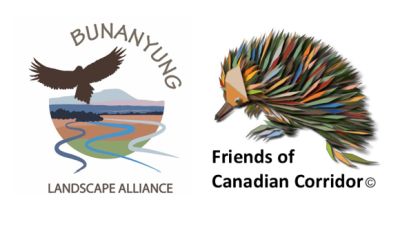
Jeff acknowledged the Wadawurrung Country from where he was presenting.
Friends of Canadian Corridor
Jeff introduced his presentation by talking about the circumstances which led to the formation of Friends of Canadian Corridor. This was mainly in response to major land changes in the Ballarat area resulting from cessation of Blue Gum plantations in the Canadian Corridor area.
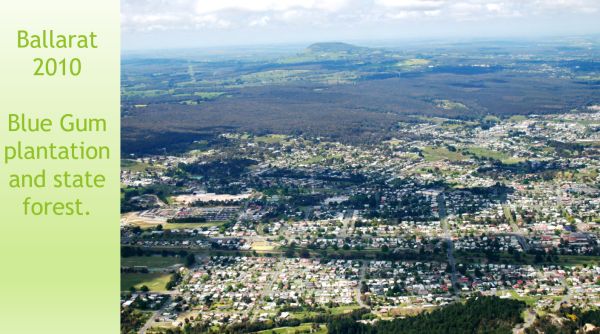
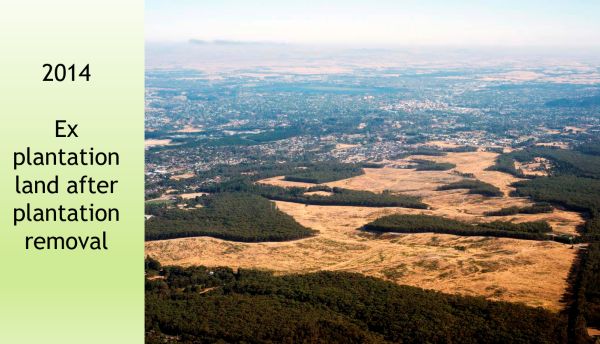
As a result of the millennium drought the plantation become unviable, subsequently the plantation was completely cleared and the land returned back to the Government in 2012.
The plantation clearing involved about 240 ha being cleared out of about 600 ha in the entire Canadian Corridor.
Taking into account the major loss of vegetation in the Canadian Corridor a number of people formed the idea that revegetation of the cleared land with native vegetation could reconnect the corridor and at the same time create a Multi-use Forest Park on the east side of Ballarat which incorporated existing state forest and 240 hectares of ex plantation land.
The Friends of Canadian Corridor was formed in 2014 and has been a driving force for the creation of the Regional Park. Jeff pointed out that in addition to restoring the corridor’s biodiversity the area has become a very important recreational area where people can be in contact with nature, walking, cycling, horse riding etc.
Advocacy
Jeff spoke about the incredible amount of advocacy and consultation involved in negotiating how the area could be managed. There are 1065 registered Friends and 82 friendly community organizations with an interest in the corridor. The Friends group also undertook tens of submissions/responses to Local and State Government agencies requests and initiatives.
Education
Jeff spoke about the need to educate people about the values of the park. The Friends Group uses a number of platforms to engage and educate people about the park’s flora and fauna and mining heritage:
- Host Web, social media and a monthly Spikey News service.
- Produce high quality brochures and maps to help bring people into the park
- Numerous media reports on TV, Radio and Press as well as social media
- Run forums, and events designed to bring greater understanding of the Corridor’s attributes
On-ground actions
Jeff spoke about the revegetation of the cleared areas and creation of recreational opportunities. E.g.:
- Plant 500 koala habitat trees every year
- Building recreational rail trail and a number of nature walks
- Citizen Science Koala monitoring
Jeff highlighted the award winning “Dementia Friendly Forest and Sensory Trail”
The Friends group also is active in supporting or objecting to planning matters which could impact on the park through degrade biodiversity e.g., ensuring Koala habitat in the broader corridor is secure.
Bunanyung Landscape Alliance
The notion of a landscape scale advocacy group was developed at a conference in 2016 in recognition that there was no community organisation looking at issues across the broader landscape south of Ballarat covering the catchments which flow towards Geelong.
The Natural Resources Environment League is a major supporter of the Alliance.
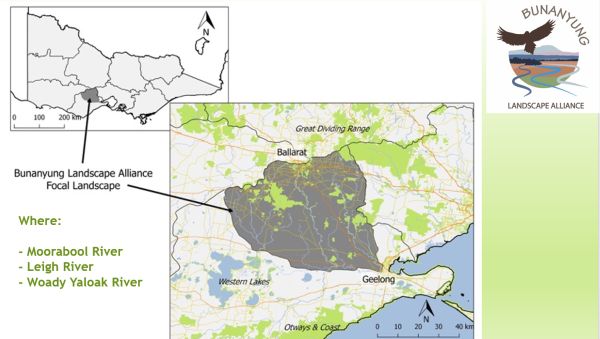
Mission
The Bunanyung Landscape Alliance is the community’s advocate for our environment. In partnership with our stakeholders, we assist in the development and implementation of shared, evidence based, visionary landscape - scale projects that protect and/or enhance our land & waterscapes. These projects will reflect the aspirations of our local member groups and our goal of engaging the broader community.
The 3 pillars of the Alliance involve: Research, Organisation and Funding.
Major goals
Biolink identification
This project is aimed at creating a biolink between the Enfield Forest and the Wombat Forest. The project involves all pillars of the Alliance: advocacy, skills and knowledge and Research.
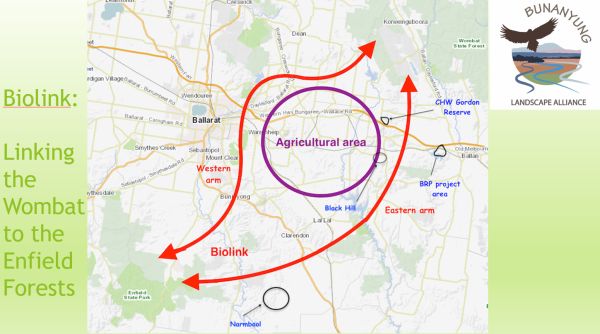
BushBank
The Alliance is one of nine strategic partners of Cassinia Environmental, being holder of the Victorian Government’s $30 m restoration project to convert 20,000 ha of private land to habitat favourable to enhancement of biodiversity.
Jeff discussed the in-depth mapping of the eastern arm of the biolink which was carried out to better understand the opportunities for rebuilding a link using stepping stones of public reserves, forested land and any other areas which could be included in the biolink.
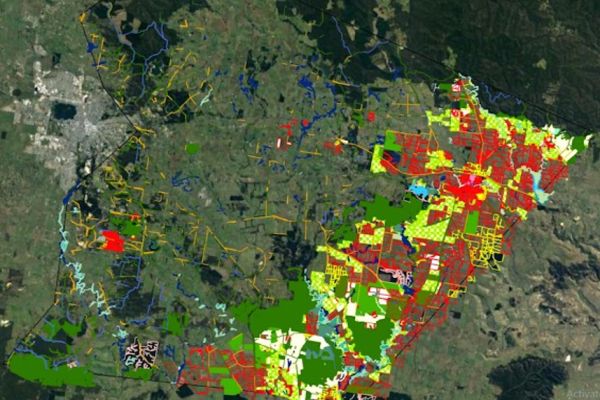
Biolink Restoration Guide
Jeff emphasised the need to understand where revegetation needs to occur and how best to achieve results using a Restoration Guide that will be published for use in the area by incorporating:
- Nursery Guide, Little Creeks strategy, Monitoring research and mapping already undertaken
- Involving small- and large-scale restoration sites at Narmbool and Black Hill (Kerrit Bareet) in conjunction with private landowners, local Landcare and Friends Groups
- Forming the basis for further landscape restoration with BushBank (Cassinia Environmental)
- Providing the Alliance and the community with a climate-adaptive goldfields landscape Restoration Guide
Other projects
Little Creeks project
The Little Creeks project received $20,000 funded by DELWP in 2020. The Little Creeks project was formed in recognition that many of the small creeks in the catchments are degraded as a result of historic goldmining in the area. Little creeks are often either denuded or weed infested and in need of revegetation. Jeff pointed out that in general, little creeks are not included in catchment management plans as they are small and at the top of the catchment.
Restoration of little creeks is a very effective means of climate adaption through revegetation and shading the waterways, improving water quality which flows into the Barwon River.
There are moves to embed the Little Creeks concept within the forthcoming City of Ballarat Biodiversity strategy.
Magpie wetland project
Jeff provided an overview of the Magpie wetland project which the Alliance has just started to look at with the aim of restoring a highly degraded area which was formerly part of the Gordon Sewerage Farm. The area contains contaminated soils and is over run with gorse. However, there is an opportunity to undertake restoration of the land and wetlands in the floodplain to improve biodiversity and the quality of water flowing into the Leigh River.
Key points form questions
People can help Friends of Canadian Corridor – details are on their web site https://www.focc.asn.au/



